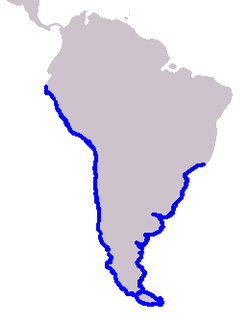Population and distribution
While Burmeister's porpoise seems to be relatively common in its range, little work has been done to survey the species. The total population is at least in the tens of thousands. Its range appears to be continuous in coastal waters from northern Peru in the Pacific Ocean round Tierra del Fuego and up to southern Brazil in the Atlantic Ocean. [1] Burmeister's porpoises frequent inshore bays, channels, and fjords, [1] but individuals have been spotted as far as 50 km (31 mi) from the shore and in the freshwater Valdivia River in southern Chile. [1] Though normally found in continental shelf waters, they have been found as deep as 1,000 m (3,300 ft) [1]
Conservation
Like all porpoises, Burmeister's is vulnerable to accidental capture in fishing nets. [1] [4] This is common in Uruguay, Peru and Chile. The annual estimated catch is largest in Peru, at 2000 individuals. [3] In Peruvian waters, Burmeister's porpoise caught as bycatch are primarily used for human consumption. [1] Until the late 1990s, Burmeister's were also harpooned deliberately for food and for use as crab bait. [1]
In severe El Nino events, the ecosystem of the Humboldt current is disrupted. Anchovies either perish or leave the area, and it appears that many porpoises and other marine mammals, including the Burmeister's porpoise, must find other food sources or starve as a result. [5] In 1997, during an El Nino event, Burmeister's porpoises were found stranded on Peruvian beaches. [5]
The IUCN lists the animal as Near Threatened in its Red List of Threatened Species. [1] The long-term prognosis for the species is unknown. [1]
Burmeister's porpoise is listed on Appendix II [6] of the Convention on the Conservation of Migratory Species of Wild Animals (CMS). It is listed on Appendix II [6] as it has an unfavourable conservation status or would benefit significantly from international co-operation organised by tailored agreements.
This page is based on this
Wikipedia article Text is available under the
CC BY-SA 4.0 license; additional terms may apply.
Images, videos and audio are available under their respective licenses.



